Solar PV Costs: How Much to Install Solar Panels & How Much Can You Save?
Solar electric panels (solar PV panels) are now the most popular renewable technology for UK households. According to the Microgeneration Certification Scheme (MCS), the standards organisation for renewable products and installers, there have been over 128,000 domestic solar PV installs so far in 2023. That’s already a 15% uplift versus 2022 (itself a record year), no doubt spurred by sky-high energy bills and the desire to reduce carbon emissions. But when it comes to solar panel costs, how much should you budget?
To help get you in the know with how this piece of renewable tech works and whether it’s worth the investment, here we’re looking into how much solar PV costs to install and how much you can save by installing solar PV panels on your home.
What You Need to Know About Solar PV Panels
Good design and installation are critical to making the most of your solar PV system. In the UK, panels should be oriented as close to south-facing as possible for best performance – but anything from south-west to south-east should deliver good yield. The ideal angle for the collectors is a pitch of around 35°, happily coinciding with the most common roof types seen across the UK.
If you’re building a new home from scratch, your designer may be able to integrate a suitable southerly pitched roof into the design – either on the house or an outbuilding, such as a garage. One critical consideration is avoiding overshadowing from trees or nearby buildings, as these will dramatically reduce the panels’ output. The potential for shading from any flues or chimneys (whether planned or existing) should also be taken into account.
You can also fit solar PV onto a flat roof using special mounting brackets, although this is likely to be more visible (not ideal if you need a flat roof for planning reasons!). If you’ve got enough garden space to provide an unshaded area, ground-mounting is an option. The yield from this kind of system can be increased with a solar tracker, which turns the panels to face the sun throughout the day.
More Advice: 12 Ways to Reduce Your Energy Bills & Create an Efficient Home
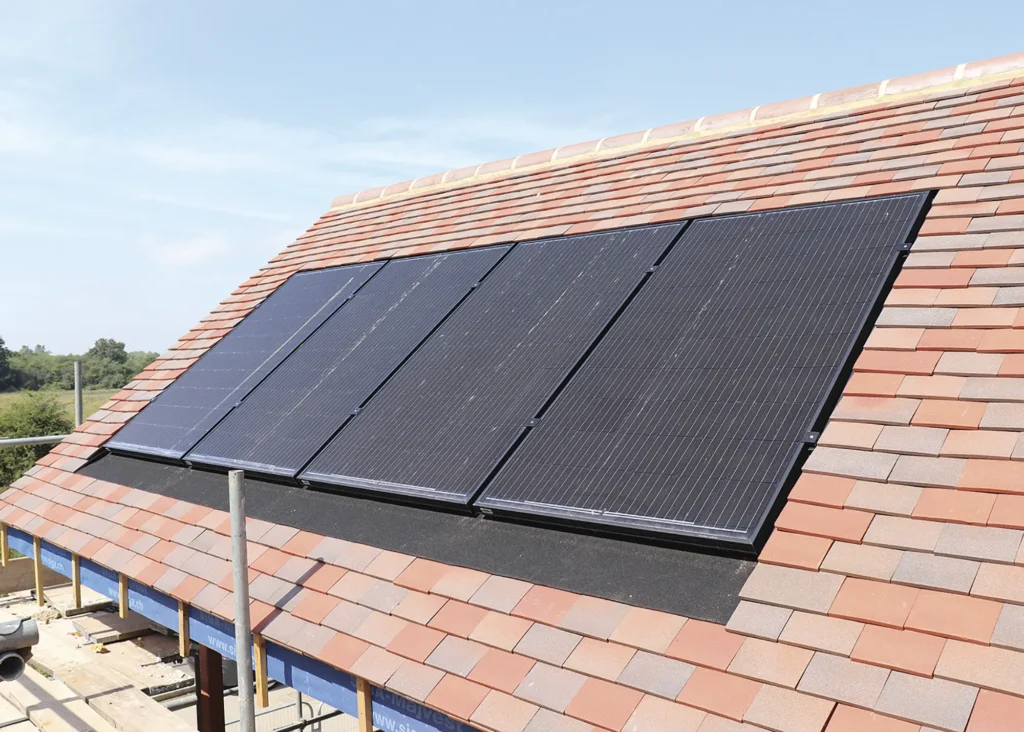
The Build It Education House features a relatively modest in-roof 2.2kW Vision solar panel PV array, supported by a 2.4kW MyReserve battery, both from Solarwatt
Solar Panel Costs – How Much does Solar PV Cost to Install?
The biggest factor for solar panel costs will be the size of the PV system you specify. The MCS collates data for certified installs across England, Scotland, Wales and Northern Ireland. This shows that, so far in 2023 (up to the end of September), the typical price per kW of installed solar PV in domestic properties was £2,193. Back in 2021, the average cost was just £1,661 per kW. So, solar panel costs have risen significantly, reflecting general construction sector inflation.
MCS data also puts the average 2023 solar panel installation cost at £10,477 in total – which would equate to a 4.78kW solar PV array (at £2,193 per kW).
The Energy Saving Trust (EST) suggests a typical domestic solar PV system is somewhat smaller, at 3.5kW and around £7,000; although that does put prices in a similar ballpark of approximately £2,000 per kW. However, for most detached properties, we’d expect households to be looking at around 4kW to 6kW (depending on number of bedrooms and occupants).
Where you’re based in the country can have a significant impact on solar PV prices. According to the MCS data, costs are generally highest in England (£2,227 per kW in 2023, measured over 104,000 installs) and lowest in Northern Ireland (£1,518 per kW across 1,316 installs).
Are there any Grants to Reduce Solar Panel Costs in the UK?
At the moment, there aren’t many funding options for solar panels in the UK. That’s because the biggest support scheme (the Feed-in Tariff) closed to new applications in 2019.
Feed-In Tariff
During the 2010s, solar panel costs were subsidised by the government’s Feed-In Tariff (FIT) scheme, which supported new solar PV installations. The FIT provided cashback payments (via energy bills) to households that self-generated renewable electricity on site.
Those who signed up in the early days bagged generous generation tariffs of more than 50p/kW, although towards the end of the scheme this had dropped to around 4p/kW. Applicants also secured export tariffs of around 4p-5p/kW.
The FIT pays out over 20-25 years and passes on to new owners, so households are still feeling the benefits today.
However, the Feed-In Tariff closed to new applications at the end of March 2019.
Learn More: Eco Homes: 30 Sustainable Self Builds to Inspire Your Eco House
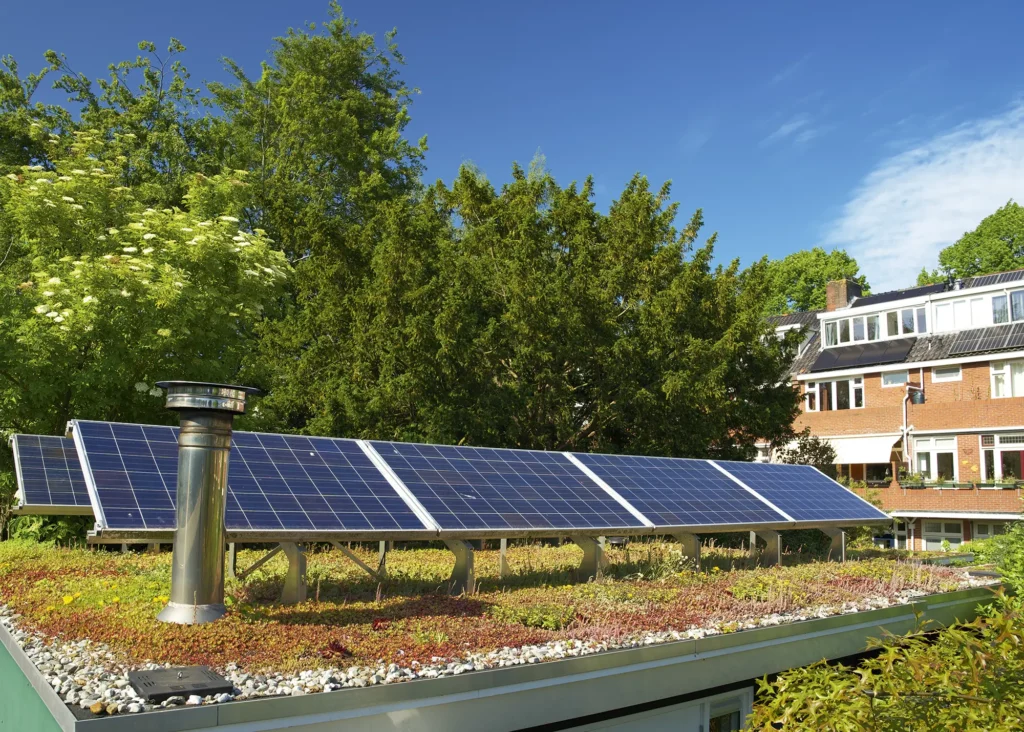
Special mounting systems can enable solar panel installation on flat roofs and in gardens. Photo: iStock.com/Rene Notenbomer
Smart Export Guarantee (SEG)
The Feed-in Tariff was replaced by the Smart Export Guarantee (SEG), which pays out only for any excess renewable electricity that’s transferred into the national grid.
All energy firms with more than 150,000 customers must offer a SEG tariff – although they can set their own rates. At the time of writing, Octopus Energy’s SEG tariff is among the most generous, offering 15p/kWh. Some suppliers offer rates as low as 2p/kWh.
In order to qualify for SEG, you’ll need to have an eligible MCS-certified installation and a suitable smart meter (check in advance, as different providers have different requirements).
The highest-paying tariffs are generally offered to customers who purchase panels directly through the energy company, and who use that firm for both supply and export. It’s important to understand exactly what system you’ll be getting before signing on the dotted line, as a small uplift in SEG payments may not always be best value for money overall.
QUICK GUIDEWhich Solar Panels are Best for You?We’ve looked at generic costs in this article, to help give you a ballpark idea of prices when installing PV – but it’s vital to secure detailed quotes for your specific project. Solar panels represent a major investment, so you want to be sure you’re getting a high-quality install and good value over the system’s full lifetime. Before you sign on the dotted line, you should have a clear understanding of the exact products being fitted, how they’ll be installed, who will do the work, predicted performance and what warranties will be provided. It’s worth scrutinising the exact system you’re buying and how that compares to the headline installed costs. For instance, different panels produce different power outputs. You’ll generally pay more for a system that delivers 540+ watts per panel versus one that provides, say, 415W per panel. But the higher output might mean you can achieve the results you want with a smaller array. Performance degradation is another key consideration, as the output you get one day after installation won’t be the same decades down the line. You can generally expect panels to drop off to about 80% of their rated performance after 20-25 years, and some manufacturers offer stronger guarantees than others on this side of things. |
Solar Panel Costs vs How Much You Can Save with PV
While the SEG is rather less generous than the tariffs offered during the early years of the Feed-In Tariff, there’s a reason we’ve covered it before looking at bill reductions from solar panels.
SEG makes a significant difference to ongoing solar panel savings and – ultimately – how quickly you can expect to achieve payback on your investment.
Bill savings for households at home all day
The most robust information available on potential solar PV savings comes from the Energy Saving Trust.
Based on a 3.5kW solar panel system costing £7,000 to install, and current energy prices (Oct 2023), its research suggests households who are at home all day can save up to £525 per year with the SEG, versus £400 without.
That equates to a payback period of 13 years if you get SEG payments, versus 17.5 years if not.
Read More: Solar PV Panels: Complete Guide to Home Solar Electricity
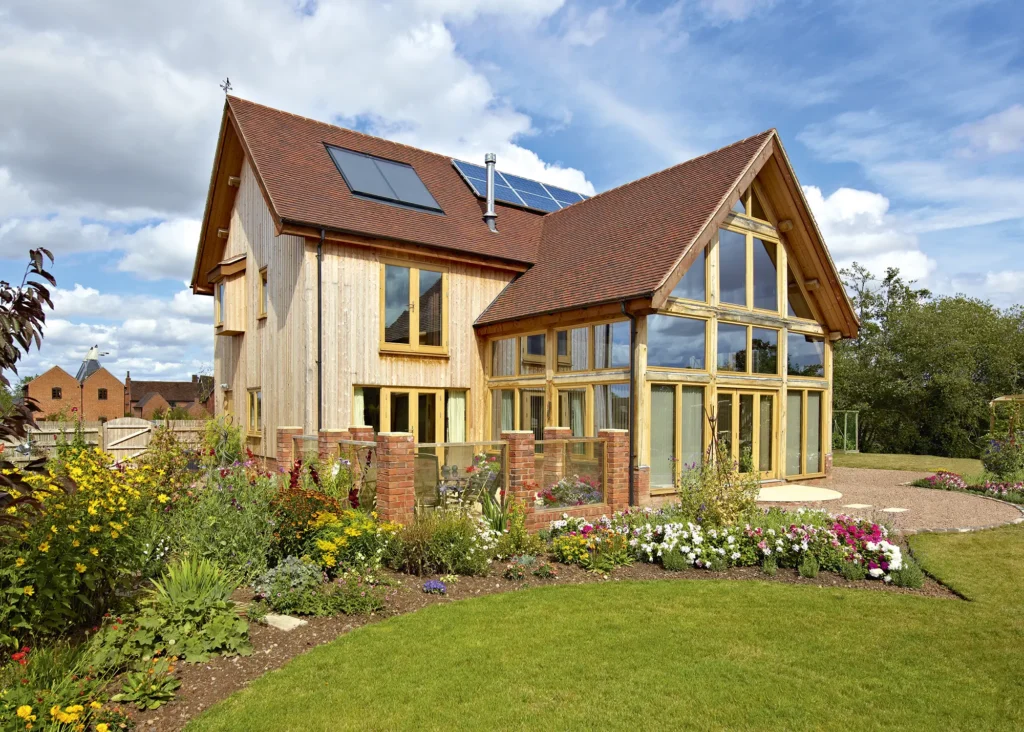
Shadows from trees, neighbouring buildings or even features of your own home – such as flues – can all reduce a solar panel array’s designed performance and prevent you from achieving the savings you might have been expecting. So, be sure your installer is accounting for such issues. Photo: Andrew Wall
Bill savings for households out during the day
At the other end of the scale, if you’re out all day until 6pm, the EST expects solar panel bill savings of up to £335 per year with SEG and £165 without. This equates to 21 to 42 years for payback on a 3.5kWp system costing £7,000.
Of course, either way, you’ll be future-proofing part of your electricity usage against future increases in energy costs . Clearly, however, usage is one of the biggest factors when it comes to maximising bill savings with solar.
In a typical working household, electricity demand reaches its peak in the mornings and evenings. But solar PV will be generating most electricity during the middle of the day. As a result, many households won’t use more than about 25% of the energy their solar panels generate.
Maximise Solar PV Panel Efficiency, Usage & Savings
With solar panel costs currently higher than they were just a couple of years ago, you’ll want to make the most of the electricity they generate to maximise savings.
There are three main options to increase the proportion of solar panel energy you use on site. One is to change your habits, for instance by installing smart appliances so that washing machines etc are programmed to run during peak generation periods.
Another is to have a solar diverter switch fitted as part of the installation. A solar diverty switch typically costs less than £1,000 and, according to the EST, should save you another £50-£100 per year. It works by using excess electricity to power your hot water tank’s immersion heater, thus reducing the need for your boiler or heat pump to generate hot water.
The third option is to install solar battery storage to help even out the peaks and troughs of energy production versus usage across the day. “With the addition of batteries, site-based consumption of PV energy can be increased to over 70%,” says Build It’s sustainability expert, Nigel Griffiths.
The downside is that a solar battery will add considerable cost to your installation – perhaps as much as 70%-80% on top of the main system. Battery technology is rapidly improving however, and prices are likely to come down as more homeowners adopt it.
































































































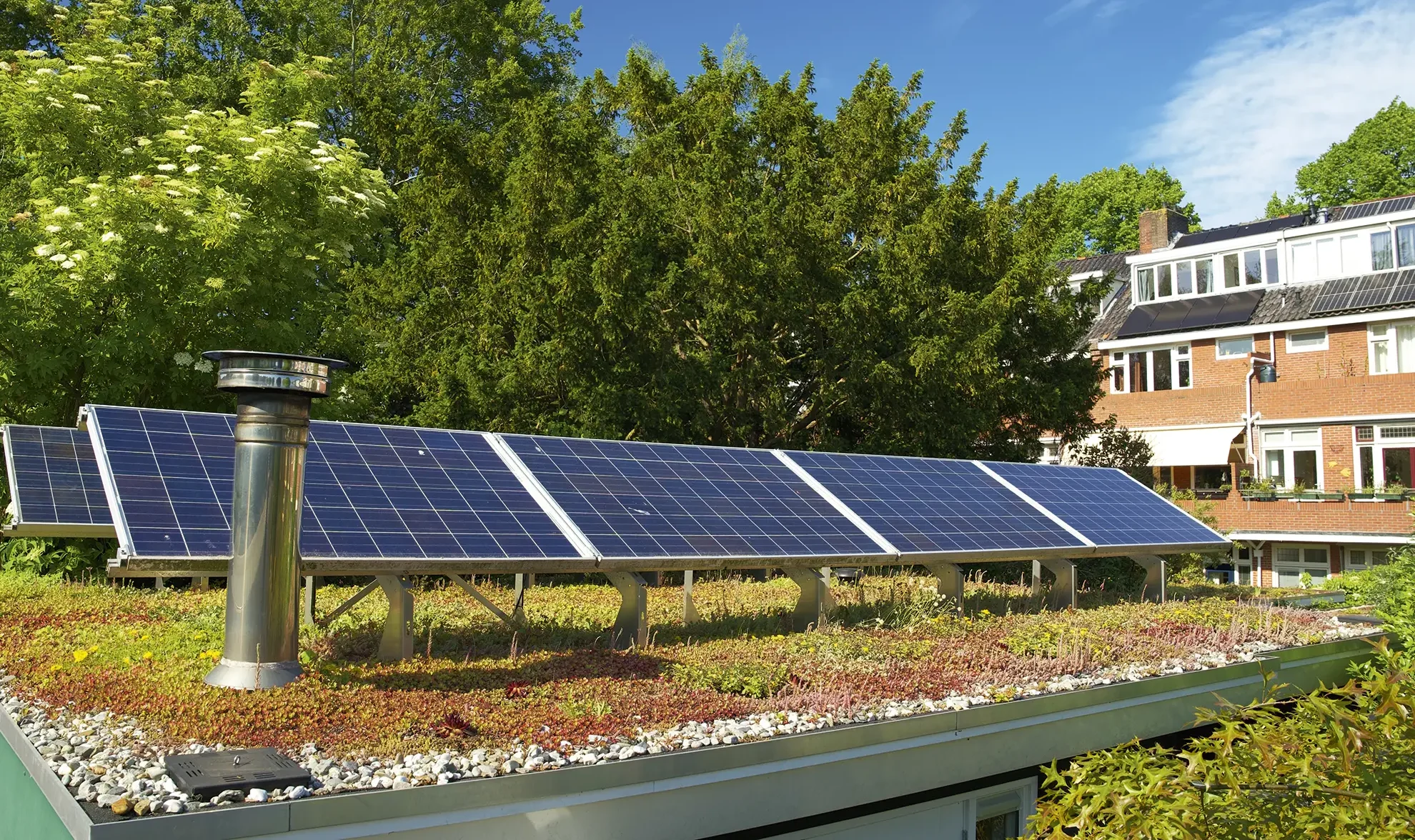
 Login/register to save Article for later
Login/register to save Article for later




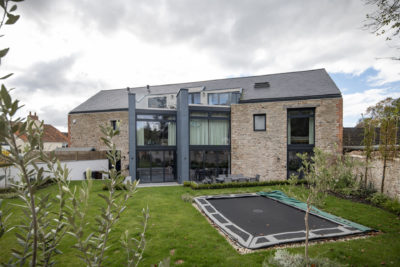
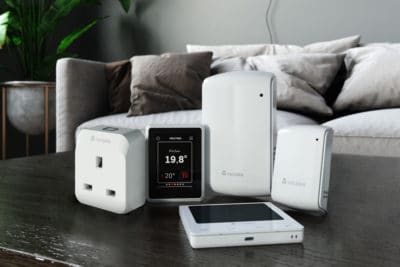
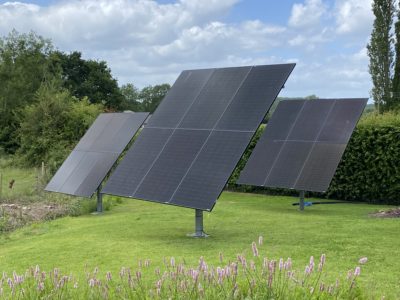
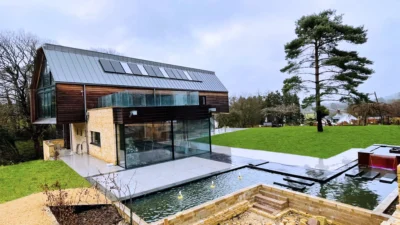





It is my personal view that solar panels alone are difficult to justify, the ROI is far too long, the shortest you mention is 13 years, the longest 42. Battery storage is the game changer, with appropriate sized batteries you can collect and store during the day and then use the power when you need to, normally evenings.
Also with batteries you can charge at night on some of the very low tariffs, this is far more significant is cost terms than the solar panels, certainly through the winter. I operate a system with modest solar PV (8kW) and 12kwh of battery storage, at the same time I converted the house to all electric heat. After going through the first year it looks as if the ROI will be about 5 years. This will vary from household to household, thermal performance of the building and your energy profile, but for us this was a very good way to go, and almost completely eliminated our fossil fuel useage. Total system cost (including electric heating) £16k.
Few articles mention that DNO approval is required and that some DNOs take up to 12 weeks to consider applications. For larger installations (above about 4 kw) the DNO may restrict the size of your inverter dependant on the local network capacity.